Originally published in November 23, 2021. Link to original article: 220Triathlon.com
Pilates can help improve your triathlon performance by making you a stronger, less injury-prone athlete. Chartered physiotherapist Helen O’Leary has the must-do movements for every triathlete…
The important thing about a triathlon is remembering that the three stages are very different and require quite different muscles. This is really important as it’s one of the reasons it’s a very difficult sport!
When warming up, you want to try and hit all these different groups and ready the body for rotation in swimming, a flexed and static body position in cycling, and repetitive impact when running. So here are the best Pilates movements for triathlon, plus the many and varied benefits of Pilates for triathletes of all ages and ability.
Top warm-up Pilates movements for triathletes The ‘Scooter’
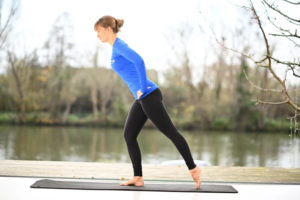
The ‘Scooter’ movement, for hip stability. Credit: Complete Pilates
This is a superb exercise to do for the running and cycling sections in particular, as it challenges flexibility, balance, leg strength and core stability, all in one!
- Stand with your feet underneath your hip joints and hands on your hips.
- Hinge at your hips so your body leans forwards, keeping your neutral spine.
- Transfer the weight into one leg and slide the other behind you and then back in.
Modifications: Push into your standing heel to find your glutes quicker. Press into the ball of your foot so that you can lift your static heel a little, this will activate your calf and ankle stabilisers as well as your glutes and big leg muscle.
The ‘McConnel squat’
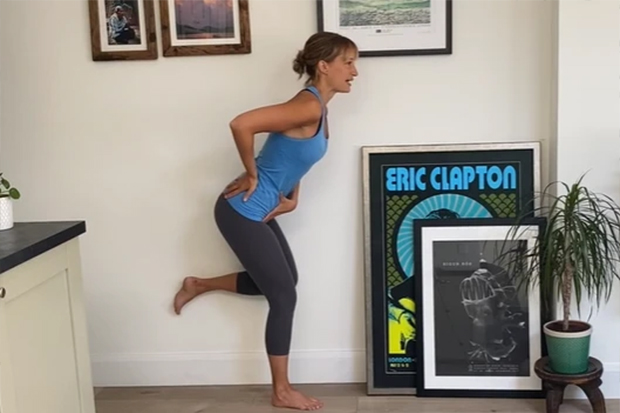
The ‘McConnell squat’ movement, for lateral hip control and activation. Credit: Complete Pilates
The McConnell squat is perfect for lateral hip control and activation. It will help you stay strong during the impact phase of the tri.
- Using a wall, lift your knee up the wall so that your leg is at a right angle.
- Push your knee into the wall, as you gently lower yourself into a pretend-seating position, ensuring your left leg doesn’t go over your foot (push this out to the left), keeping your back straight – hold for 1o seconds.
- Swap and do the other leg.
- Repeat.
The ‘Standing footwork’
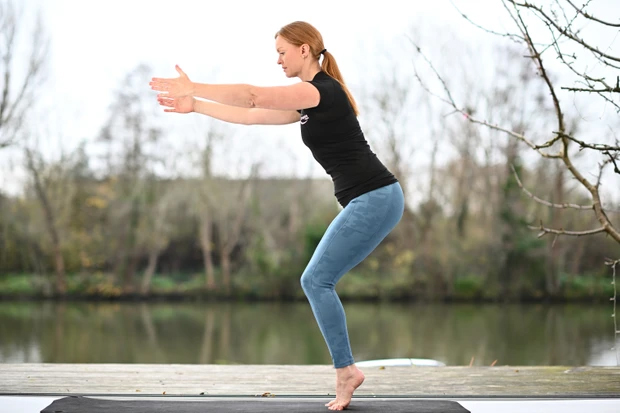
The ‘Standing footwork’ movement, for balance and coordination. Credit: Complete Pilates
This exercise will help you with your balance, coordination and get those calf muscles working well! You can reverse the movement as well so that you are working in both directions.
- Stand with your feet under your hips and hands on your pelvis.
- Keeping your knees straight, come up onto your tip-toes on both legs.
- Stay on the balls of your feet and squat down.
- Lower the heels to the floor.
- Stand back up.
The ‘Swan’
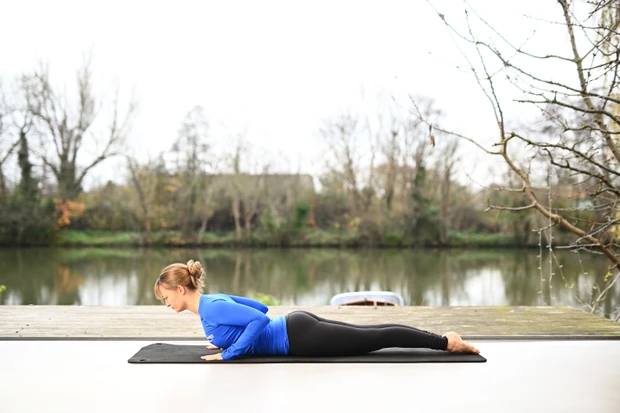
The ‘Swan’ movement, for back strength. Credit: Complete Pilates
This is brilliant for the swim leg of a triathlon to get your upper back moving as well as the muscles in the back of your body working.
- Lay on your front with your hands next to your chest.
- Press your pubic bone into the floor and reach your feet away from you, keeping them on the floor.
- Inhale and gently press into your hands, allowing your upper back to lift off the floor. Keep your lower ribs on the floor.
- Exhale to come back down again.
Modifications: You can continue to move with your breath, putting less and less weight through your arms so that the back of your body does more. You can also pause at the top for a full breath cycle, trying to stay high, before coming back down again.
The ‘Full dead bug’
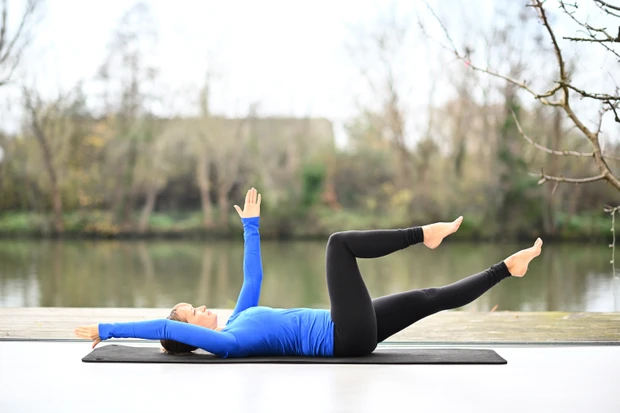
The ‘Full dead bug’ movement, for core stability. Credit: Complete Pilates
This exercise is great for core stability so perfect for all three activities. It will also help to warm up your shoulders, ready for front crawl.
- Lay on your back and bring your arms up towards the ceiling, palms facing each other, and legs into tabletop (90/90).
- Pause in this position and make sure the natural curves of your back are here. You should feel weight into three spots – the back of your head, back of your ribs and the back of your tail.
- Take one leg away from you, making sure it goes completely straight and point the toes so the whole leg is active.
- At the same time, reach the opposite arm overhead.
- Try to keep the pressure in those three heavy spots the same.
- Move slowly to challenge yourself – aim for a count of four out, then come back into the starting place quicker.
- Alternate sides before switching to the same side arm and leg.
The benefits of Pilates for triathletes
Stability
We need this in all components of a triathlon but in quite different ways. Think of stability as reducing excessive movement. This means that you can conserve energy rather than expending it on poor technique. In swimming, you need the stability around your trunk to keep you streamline in the water. In cycling you also need it here, so that you can keep your torso quiet as your legs are moving as fast as possible. In running, you want to be able to avoid collapsing into your hips or swaying from side to side.
Running is also an impact sport. Up to 3x your body weight goes through each foot on each contact when you run. This is a lot! Consequently, we need to have stability around our joints to help support us. Pilates works on all the deeper muscles and helps to strengthen these. As a result, they can work more efficiently when you run so that you can keep on going.
Injury prevention
At some point, we will unfortunately all pick up some kind of injury. However, you can prevent a lot of these by doing the right thing for your body. This means working on some of the weaknesses you have so that you can distribute the force through your body (remember 3x your body weight on each stride). Pilates will break down your movement and then we can use the equipment to re-build it, making you the most efficient you can be.
Warm-up
We should all warm up and activate muscles before we compete or train. You see this all the time at an elite level. Activating the muscles you know don’t necessarily switch on that quickly is a great way of waking them up. Pilates is brilliant at this as it can target groups of muscles to warm them up and get them firing well before you run. Plus it doesn’t have to take long as your warm up should be tailored to you.
Active recovery
We all need rest days. This is so that your body can recover, heal and build muscle. On these days doing something low impact, which focuses on a completely different type of activity is a great way to keep the body moving. Pilates is perfect for this as it’s non-impact, uses some resistance and will help to stretch and mobilise the body and spine.
Body awareness
Pilates is an amazing way of helping you to build body awareness. It’s all about where your body is in space and making sure you can feel it. This is key when it comes to running as it will help you to analyse your movement better and therefore make appropriate changes. This will help your technique in all the disciplines, ensuring you can put any coaching suggestions into practice easier.
Mobility
To be able to swim, you need to be able to have a good range of movement in your shoulders, rotate well in your upper back and be able to extend; to cycle, you need to be able to flex forwards and maintain this position; in running, you want to be able to get into hip extension in order to drive yourself forwards as effectively as possible.
As you’re getting stronger, you need to make sure you can still access your mobility so that you can generate power well.
[/module_left]

Comments are closed.